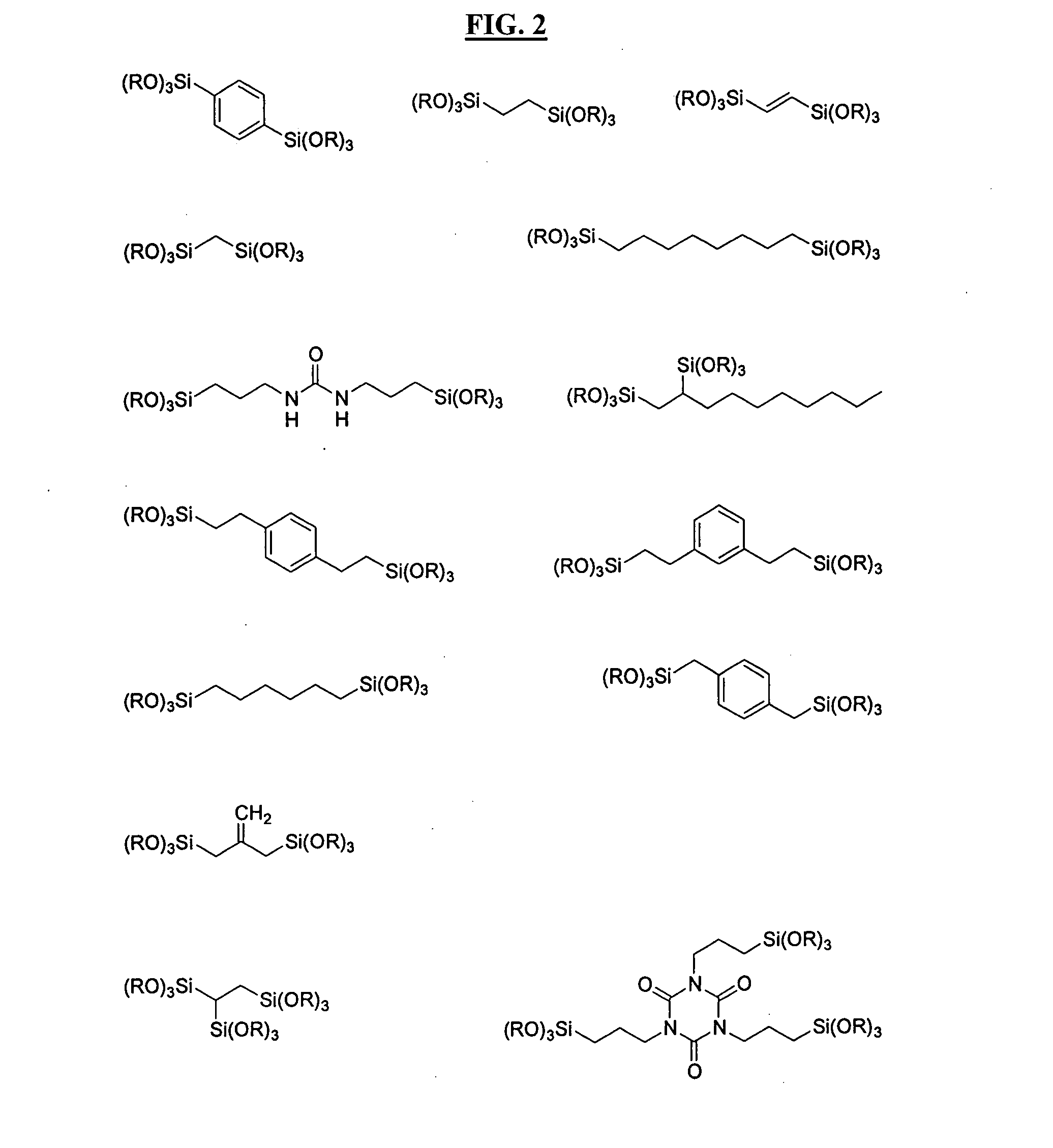Hardmask composition and associated methods
a composition and hardmask technology, applied in the field of hardmask composition, can solve the problems of poor etch selectivity between the arc material and the patterned resist layer, the resist layer may be undesired consumed, and the resist material used in some lithographic techniques does not provide resistance to the subsequent etching step, etc., to achieve the effect of enhancing etch resistance, increasing hydrophilicity of the organosilicon copolymer, and increasing storage stability
- Summary
- Abstract
- Description
- Claims
- Application Information
AI Technical Summary
Benefits of technology
Problems solved by technology
Method used
Image
Examples
example 1
[0073]1,375 g of methyltrimethoxysilane, 286 g of phenyltrimethoxysilane and 740 g of bis(trimethoxysilyl)methane were dissolved in 5,600 g of PGMEA in a 10-liter four-neck flask equipped with a mechanical agitator, a condenser, a dropping funnel and a nitrogen inlet tube, and then 654 g of an aqueous nitric acid solution (1,000 ppm) was added thereto. After the resulting mixture was allowed to react at 50° C. for one hour, the formed methanol byproduct was removed under reduced pressure. The reaction was continued for one week while maintaining the reaction temperature at 80° C. After completion of the reaction, hexane was added to the reaction mixture to precipitate a polymer represented by Formula 9:
{(SiO1.5CH2SiO1.5)0.2(CH3SiO1.5)0.7(PhSiO1.5)0.1}n (n=50-400) (9)
[0074]The polymer was filtered to obtain a sample. 2.0 g of the sample was added to 100 g of PGMEA to prepare a dilute solution. 0.002 g of pyridinium p-toluenesulfonate was added to the dilute solution. The resulting s...
example 2
[0075]1,632 g of methyltrimethoxysilane and 768 g of bis(trimethoxysilyl)methane were dissolved in 5,600 g of PGMEA in a 10-liter four-neck flask equipped with a mechanical agitator, a condenser, a dropping funnel and a nitrogen inlet tube, and then 654 g of an aqueous nitric acid solution (1,000 ppm) was added thereto. After the resulting mixture was allowed to react at 50° C. for one hour, the formed methanol byproduct was removed under reduced pressure. The reaction was continued for one week while maintaining the reaction temperature at 50° C. After completion of the reaction, hexane was added to the reaction mixture to precipitate a polymer represented by Formula 10:
{(SiO1.5CH2SiO1.5)0.2(CH3SiO1.5)0.8}n (n=50-400) (10)
[0076]The polymer was filtered to obtain a sample. 2.0 g of the sample was added to 100 g of PGMEA to prepare a dilute solution. 0.002 g of pyridinium p-toluenesulfonate was added to the dilute solution. The resulting solution was spin-coated on a silicon wafer, ...
example 3
[0077]686 g of methyltrimethoxysilane and 1,714 g of bis(trimethoxysilyl)methane were dissolved in 5,600 g of PGMEA in a 10-liter four-neck flask equipped with a mechanical agitator, a condenser, a dropping funnel and a nitrogen inlet tube, and then 462 g of an aqueous nitric acid solution (1,000 ppm) was added thereto. After the resulting mixture was allowed to react at 50° C. for one hour, the formed methanol byproduct was removed under reduced pressure. The reaction was continued for 3 days while maintaining the reaction temperature at 50° C. After completion of the reaction, hexane was added to the reaction mixture to precipitate a polymer represented by Formula 11:
{(SiO1.5CH2SiO1.5)0.5(CH3SiO1.5)0.5}n (n=50-400) (11)
[0078]The polymer was filtered to obtain a sample. 2.0 g of the sample was added to 100 g of PGMEA to prepare a dilute solution. 0.002 g of pyridinium p-toluenesulfonate was added to the dilute solution. The resulting solution was spin-coated on a silicon wafer, fo...
PUM
| Property | Measurement | Unit |
|---|---|---|
| composition | aaaaa | aaaaa |
| hardmask composition | aaaaa | aaaaa |
| weight | aaaaa | aaaaa |
Abstract
Description
Claims
Application Information
 Login to View More
Login to View More - R&D
- Intellectual Property
- Life Sciences
- Materials
- Tech Scout
- Unparalleled Data Quality
- Higher Quality Content
- 60% Fewer Hallucinations
Browse by: Latest US Patents, China's latest patents, Technical Efficacy Thesaurus, Application Domain, Technology Topic, Popular Technical Reports.
© 2025 PatSnap. All rights reserved.Legal|Privacy policy|Modern Slavery Act Transparency Statement|Sitemap|About US| Contact US: help@patsnap.com



